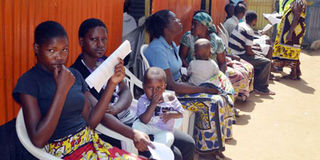City slums account for 30 per cent of TB cases

Patients await medical check-ups during the launch of the Kenya Tuberculosis Prevalence Survey for 2015-2016 in Mshomoroni, Mombasa County, on September 25, 2015. The number of tuberculosis cases in the country has dropped by 40 per cent. PHOTO | KEVIN ODIT | NATION MEDIA GROUP
What you need to know:
Health PS Nicholas Muraguri noted that the burden of drug resistant TB was becoming a big problem for the country due to late diagnosis.
To reduce the occurrence of MDR-TB, Dr Muraguri said there was a need for people who have persistent coughs to go for testing.
The disease ranks as the fourth leading cause of death in Kenya, with over 81,000 cases and 10,000 deaths (27 deaths per day) reported last year.
City slums are said to be the worst affected as they account for almost 30 per cent of TB cases.
The number of tuberculosis cases in the country has dropped by 40 per cent. However, the Ministry of Health says more still needs to be done in testing if the country is to eliminate the disease.
While celebrating the 34th World TB Day on Thursday, the Health ministry officials, health experts and legislators emphasised the need for early diagnosis to detect Multi-Drug Resistant TB (MDR-TB), which they said could hamper the strides made in the fight against the disease in the country.
Health Principal Secretary Nicholas Muraguri noted that the burden of drug resistant TB was becoming a big problem for the country due to late diagnosis.
“Although the 2015 drug resistant TB survey shows that resistance has lowered, it still remains a major health concern,” said Dr Muraguri.
To reduce the occurrence of MDR-TB, Dr Muraguri said there was a need for people who have persistent coughs to go for testing.
“We often dismiss coughs as simple infections that we can treat using off-the-counter medicines and before we realise that it is persistent, the bacteria mutates to become resistant to medicines,” said the PS.
He went on: “If we are to address this problem in this country, we must have a high index of suspicion and get checked even for the slightest of coughs.”
TB is caused by a highly contagious bacteria called Mycobacterium tuberculosis, which attacks the lungs and can also damage other parts of the body.
On the other hand, drug resistant TB occurs when the bacteria becomes resistant to one of the common TB drugs, rifampicin.
The disease ranks as the fourth leading cause of death in Kenya, with over 81,000 cases and 10,000 deaths (27 deaths per day) reported last year.
TB CASES PREVALENT IN SLUMS
City slums are said to be the worst affected as they account for almost 30 per cent of TB cases.
Currently, one in every three (14.4 million) people has the TB bacteria lying dormant in their bodies, meaning they neither present the symptoms nor fall sick.
Nairobi County accounts for 15 per cent of the country’s TB burden and spends slightly over Sh200 million annually to diagnose and treat TB.
It costs the country nearly Sh11 billion annually in hospitalisation costs, deaths and out-of-pocket expenditures for TB care and absenteeism from work.
According to the WHO, an estimated 9.6 million new TB cases and 1.4 million deaths are reported worldwide.
The UN agency notes that another three million cases are missed by health systems annually and may not get adequate care. Even worse, MDR-TB remains a crisis, with only four cases detected, and one in two cured.
WHO country representative Custodia Mandlhate said the country needs to double its efforts to further reach, treat and cure all patients. “For us to eliminate the disease, we need to invest more. It is, however, gratifying to note that the response to TB control has increased due to new interventions,” said Dr Mandlhate.





